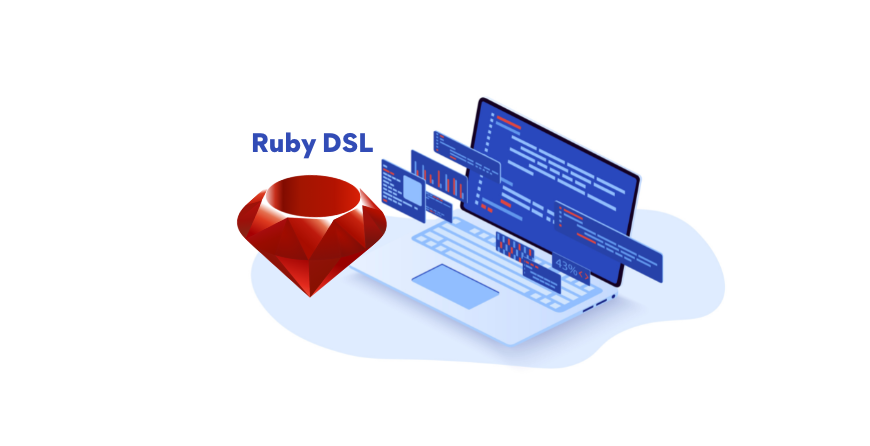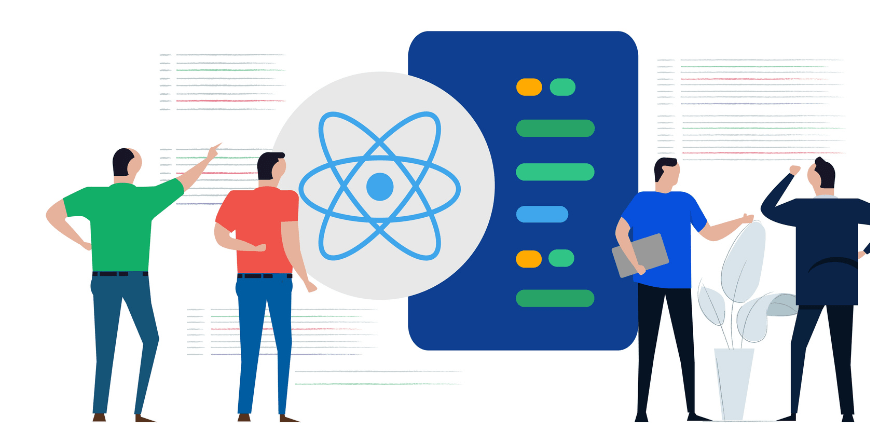Ruby DSL is among Ruby metaprogramming’s intriguing features. Oftentimes, the goal of metaprogramming is to create a DSL with limited expressiveness focused on a particular domain.
A Domain Specific Language brings efficiency to a particular domain task by removing code complexity and enhancing its code readability.
It’s common among developers to rely on different DSLs to easily program or configure complex systems.
However, not all Ruby on Rails developers are aware of this concept since it uses advanced metaprogramming, so let’s thoroughly understand the concept of Ruby DSL, why to use it, what are its real-world examples, and what benefits it holds for your Ruby on Rails development.
What is a DSL in Ruby?
A domain-specific language is a sublanguage within a programming language. similar to a mini-game inside a game that offers some additional gameplay.
These domain-specific languages have specific syntax for describing a domain of a particular application.
This means they can only be utilized for specific areas and are not suitable for general-purpose software development.
Types of Domain-Specific Languages
Markup DSLs
Markup languages were created to define the structure, style, and layout of web pages. HTML, CSS, and XML are some of the popular markup languages that are used only for webpage structuring, and since they lack algorithmic program creation, they are categorized as DSLs.
Query and Macro DSLs
The query and macro languages’ capabilities are limited, and because they can only be used on top of a specific system for inserting, modifying, and extracting data from databases, they fall into the DSL category. For example, SQL and DOT.
Internal DSLs
Internal DSLs were created cleverly. They don’t have their own syntax; instead, they rely on the syntax of a general-purpose programming language, which is easy for any developer to get used to. An internal DSL can also be referred to as a mini-language since it has the same syntax as a language but expresses the tasks in a better way.
Ruby DSL is written in the Ruby language, which means it belongs to the category of internal DLS. It provides a much cleaner and nicer interface and language for performing tasks compared to ordinary Ruby codebases.
Related Post: Top Reasons to Migrate from Monolithic Apps to Ruby on Rails Microservices
DSLs vs GPL: Advantages of DSLs
Though Ruby’s DSLs and other domain-specific languages have limitations in the things they can do because of their specialization, they are dominant in their own limited domain as compared to general-purpose languages.
Let’s see some of its advantages:
- >> We can examine them much better: while it is impossible in practice to guarantee that a program is written in general-purpose language regarding certain characteristics like stopping infinite loops, we get the ability to perform analyses when we use DSLs. Specifically, because their operations are limited and they can be easily analyzed.
- >> They are secure. Hardly anything can go wrong with the DSL. Have you ever noticed any errors like null Pointer Exception when working with HTML or SQL? Precisely, you haven’t.
- >> Even if there are errors they are related to the domain so they are easier to understand and can be fixed within a short period. These errors are not about null pointers, they are more aligned to the domain and only a domain expert can understand them. Contact us to hire the Ruby on Rails experts.
- >> This also brings us to the fact that the interpretation is easier, so deploying them to a new platform is easy. The same goes for the simulators. The exact HTML documents we could open on a PDA in the early 2000s can now be opened on an iOS/Android device.
- >> We can command them more easily since they have a limited scope so shorter time and less training are required to master them simply because there is less stuff to study.
- Related Post: Ruby on Rails VS Node JS: An in-depth comparison
What Can We Do With Ruby DSLs
Now that we know what DSLs are let’s take a look at what can we do with Ruby DSLs
- > The Ruby DSLs can be used to define commands for executing N number of tasks at once.
- > They also help in describing some aspects of documents like structure, and layout.
- > We can use Ruby DSLs to define rules of operations and business processes for a streamlined execution.
Other than this, DSL can work for specific tasks, but we can also use combined DSLs to describe several other facets of the product. For instance, HTML, CSS, and Ruby’s internal DSL can be used in combination to define the structure, layout, and styles of web pages.
Related Post: A Detailed Guide on How to Use Ruby Threads
Why Should We Use Ruby DSLs- Real-World Examples
DSLs are easier to understand by anyone and can be used on top of any system to operate or assess its characteristics, which is why Ruby DSLs are beneficial for every industry.
They help different industries by,
- Building a medium of communication between the domain experts, the system, and the developers
- Increasing focus and productivity
Let’s get more into details,
Communication Between the Domain Experts, System, and Developers
As an employer, you will like the RoR developer to collaborate with domain experts from different industries to build a software solution. Since these domain experts have no prior knowledge of or relation to programming languages, they won’t be able to understand the product’s key aspects. In this scenario, you have to come up with a solution, and this is where Ruby DSL comes in handy.
For instance,
- You could develop medical software solutions and need to communicate with physicians to understand what treatment a particular software should suggest.
- You could develop software for the automobile industry where you would need to communicate with automobile engineers to understand how to control the brakes, engine, and other vehicle parts.
- You could develop a marketing automation application where you would need the marketing people to describe to you how to identify customers matching a certain profile, to offer them a particular deal or compensation.
As we said earlier, domain experts are not developers, which is why we have to come up with a Ruby DSL that can be understood by these domain folks, the developers, and the software to execute instructions and commands.
In this manner, a domain expert can describe what the software should do, and the developer can code that specific command in DSL, which will provide instructions to the software for performing the required actions. You can contact Optymize talent marketplace to hire the best Ruby on Rails developers.
And since Ruby DSLs are easy to grasp, domain experts won’t have a hard time understanding and criticizing the command or instructions, by which they can look at the code, ask developers to modify it, and see through the results.
Additionally, DSLs are smaller and more compact and can be written within a few hours, which signifies a short turnaround.
Tip: Make the top Ruby on Rails Development Company your technology partner and build robust web apps to boost revenue.
Increased Focus And Productivity
Ruby DSL shadows the technical aspects of the program to focus on the important parts of the code, like logic, which increases focus and productivity.
It brings value to the program by executing simpler operations within a few seconds. You can change the interpreter you are using, but the DSL code remains the same and carries out its operation flawlessly.
So even if a company put its DSL in a system 20 years ago, even with the changes in the DSL interpreter, Ruby DSL still manages to produce the same results with the same accuracy.
And the reason for this is, Ruby DSL only captures the logical part, which is the backbone of every program, and the technical details get abstracted by the compiler, so we only have to change the DSL compiler to preserve the value of the logic and make it usable in a more advanced context. This gives a huge boost to productivity since no one has to get into technical details that much.
With the use of DSL, we can separate domain logic and technology and make them transform separately.
Related Post: A Guide on How to Build a Ruby on Rails API
Benefits of Ruby Domain-Specific Language
You can reap a multitude of benefits using Ruby DSL.
The most apparent benefit you get from using Ruby DSLs is that, once you choose a language like Ruby and its transformation engine, it becomes efficient and easy for you to cover aspects of software development, as you don’t have to do the grunt work manually.
While generating source code from the DSL program, you can use domain-specific abstractions without worrying about any runtime overhead, because the generator removes the complex technical aspects and generates efficient code.
Suppose you are expressing domain concerns in an application. In a language that is closely aligned with the domain, your thoughts become clearer because the code you write is not loaded with implementation details. In other words, using Ruby DSLs allows you to separate essential or business logic from incidental complexity.
It builds a strong integration between the developers and domain experts since the DSLs, express domain, abstractions, and notations are aligned with how domain experts think.
Using DSLs, you can increase the quality of the created product with fewer bugs, a better architectural structure, and increased maintainability. This removes unnecessary degrees of freedom.
Related Post: Ruby on Rails vs Django: Which Web Framework is Better
Conclusion
There you have it, a guide on Ruby DSL that explains its very concept, from the core to real-world examples. And as said above, Ruby DSLs are very useful in everyday life and can be understood and even modified by domain experts who don’t have any prior programming knowledge.
Furthermore, Ruby DSLs and other DSLs bring a collaborative space and integrity between the developers and domain experts, which enhances a particular program’s task execution in specific and combined parts.
If you’re eager to write your customized DSL, consider starting with what it does rather than how to write, because if you understand what they are and where they shine, you’ll have a good idea whether it fits your project requirements or not.
Still, you can browse online DSL tutorials where you can learn how to write Ruby DSL with Ruby metaclasses and Ruby instance_eval.
You can also take the help of the Ruby DSL handbook by Jim Gay to write powerful and flexible Ruby apps using some advanced techniques.





